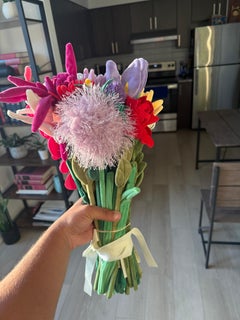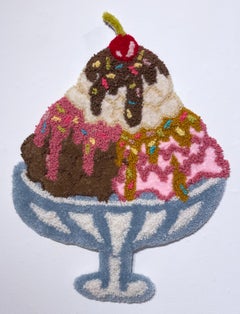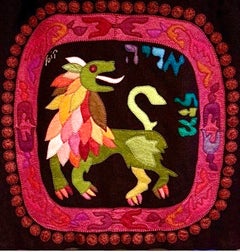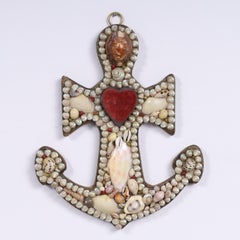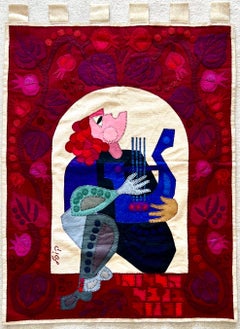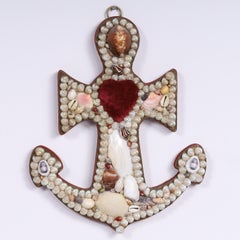Felt More Art
to
7
3
8
1
15
Overall Width
to
Overall Height
to
1
8
25
10
8
3
1
23
5
4
801
7,084
4,062
3,428
2,870
13
4
1
1
34
Medium: Felt
CJ Hendry Flower Market 2.0 ALL 27 FLOWERS Limited Edition NYC Pop Up
Located in Draper, UT
CJ Hendry Flower Market 2.0 ALL 27 FLOWERS Limited Edition NYC Pop Up
Materials
Polyester
Size
17 × 7 × 5 in 43.2 × 17.8 × 12.7 cm
Rarity
Unknown edition
Medium
Sculpture
Condit...
Category
2010s Contemporary Felt More Art
Materials
Wire
Bake Sale: Ice Cream (20232), tufted wall art, textile, fiber, yarn, pink, soft
By SarahGrace
Located in Jersey City, NJ
Bake Sale: Ice Cream (2023), tufted art, textile, fiber, yarn, soft sculpture, pink, teal, wall or tabletop rug
"Bake Sale: Ice Cream" by SarahGrace is a hand tufted wall...
Category
2010s Contemporary Felt More Art
Materials
Fabric, Yarn, Felt
Wool Felt Applique Israeli Folk Art Lion Signed Tapestry Kopel Gurwin Bezalel
By Kopel Gurwin
Located in Surfside, FL
This tapestry depicts a Lion, In Hebrew Mazel Aryeh (the Zodiac symbol Leo,) all handmade. woven and stitched.
Kopel Gurwin (Hebrew: קופל גורבין) (1923–1990) was an Israeli tapest...
Category
20th Century Folk Art Felt More Art
Materials
Wool, Felt
Antique Anchor Form Sailors Valentine
Located in Palm Beach, FL
Antique sailors valentines from the West Indies in an unusual anchor form, hand decorated in exotic seashells and featuring pincushions, giving function to form.
Category
Early 20th Century Victorian Felt More Art
Materials
Organic Material, Felt
Wool Felt Applique Israeli Folk Art Signed Tapestry Kopel Gurwin Bezalel School
By Kopel Gurwin
Located in Surfside, FL
This depicts KIng David reciting Psalms, Hallelujah in Hebrew
Kopel Gurwin (Hebrew: קופל גורבין) (1923–1990) was an Israeli tapestry wall hanging, painter and graphic artist.
Kopel (Kopke') Gurwin (Gurwitz) was born and raised in Vilna, the capital of Lithuania. He spoke Yiddish at home, but simultaneously studied Hebrew at their school which was part of the Tarbut educational network. Kopel was active in the Hashomer Hatzair youth movement. In the 1930s, as a teenager, Kopel helped his parents with the home finances by working in a suit workshop, there he first encountered the art of sewing.
With the outbreak of the Second World War and the German invasion of Vilna, the Jews were imprisoned in camps and ghettos. Kopel and his brother Moshe were separated from their parents and were put to work in coal mines and peat. Kopel's parents were taken to the Stutthof Nazi concentration camp where they died of typhus within a month of each other. Kopel's 12-year-old sister Chava was turned over to the Germans by a Polish family and murdered.
The brothers were arrested by the Germans, but were saved thanks to the connections of Nina Gerstein, Kopel's drama teacher. They hid in an attic until they were discovered, fled and moved to Riga, where they were caught and sent to the Stutthof concentration camp where they were imprisoned until the end of the war. They were put to work maintaining and cleaning trains and took part in one of the death marches. In July 1946, Kopel and Moshe sailed to Helsingborg, Sweden, as part of operation "Folke Bernadotte", in which Sweden took in ill survivors for rehabilitation. Once he recovered, Kopel worked in a publishing house and later was appointed director of the local branch of the Halutz movement.
In 1950 Kopel and Moshe made aliyah to Israel. Kopel worked as a survey for the Survey of Israel Company. In 1951, he enlisted to the Communication Corps and served as a military draftsman. There he won first prize for the design of the front cover of the Communication Corps bulletin.
With his discharge from the army at 29 he started studying drawing and graphics at the Bezalel Academy of Arts and Design in Jerusalem. Among his teachers were Isidor Ascheim, Shlomo Vitkin, Yossi Stern and Jacob Steinhardt. At the end of his first year of study, Kopel won the Reuben and Sarah Lif Excellence Award in written studies. During his studies he also won additional prizes: In 1956 he won first prize from the Lethem Foundation in California for poster design. Later the same year, Kopel won the Hermann Struck prize for his drawing on the theme of Jerusalem.
In 1957 he won an additional first prize from the Lethem Foundation and second place from the printing company Ortzel for a drawing for a Jewish New Year greeting card. In 1958 he won first prize in a competition to design a poster for Tel Aviv's jubilee.
Two years later he won three other awards: First and third prize for designing a poster for Israel Independence Day, celebrating 12 years of the State of Israel.
Also that year Kopel won first prize for a poster to mark the 25th Zionist Congress.
In 1964 he entered the Independence Day poster competition on the theme of aliyah and won first and second prize. Four years later he again entered the competition on the theme of 20 years of Israel's independence and won first prize. The poster was styled like a Holy Ark curtain with two lions and a menorah at its centre. This poster appeared on the cover of the famous book Jewish Art and Civilization, edited by Geoffrey Wigoder as well as the record Voices of 20 Years, 1948-1968, edited by Yossi Godard. In April 1971 he won first prize in the Independence Day poster competition for the fourth time.
Kopel's Folk Art tapestry won the Israeli Independence Day Poster Contest in 1968
With the completion of his studies at Bezalel Kopel moved to Tel Aviv and was hired by Shmuel Grundman's graphics and design studio. Grundman took him to Europe with him to design and supervise the construction of Israeli exhibition pavilions. During his time at Grundman's he discovered the fibrous felt from which he produced most of his wall hangings. At the 1964 Levant Fair exhibition he used felt stuck onto wooden panels for the first time.
The first felt wall hanging that Kopel produced was intended for the American Cultural Centre in Jerusalem and its theme was the United States Declaration of Independence. The wall hanging, which measured 2.85 X 1.85 meters, was stuck on a wooden panel. Kopel ordered rolls of felt from France and began work on wall hangings based on bible stories. He used a needle, hand sewing small even stitches with black embroidery thread which framed and highlighted every detail in the work, as well as using appliqué. The interior designer, Alufa Koljer-Elem, introduced him to Ruth Dayan who managed the shop Maskit in September 1967 he opened his first solo exhibition at the Maskit 6 gallery, in which 12 wall hangings were displayed.
In light of the exhibition at Maskit 6, Meira Gera, the director of artistic activity at the America-Israel Cultural Foundation, organized an additional exhibition of his works at the foundation's exhibition hall in New York City. The exhibition sparked immense press interest, and was also displayed for a few months at the New York Jewish Museum, from where it travelled throughout the United States.
Followed by the exhibition at the Delson-Richter gallery in Old Jaffa, which was later also exhibited at the Jerusalem Theatre.
Kopel's tapestry "The Time for Singing has Arrived" was printed on a UNICEF greeting card in 1978 and again in 1981.
The Israeli Philatelic Service issued three stamps based on three of Kopel's holy ark curtains and one stamp based on an Independence Day poster he designed.
Kopel's creations decorate a large number of synagogues, public buildings, hotels and private collections which were purchased in Israel and around the world. They have decorated, among others, the walls of the King David Hotel in Jerusalem, the VIP room at Ben Gurion Airport, the Kfar Saba theatre and the Plaza Hotel in Tel Aviv.
Israel has had a Vibrant Folk Art, Naive art scene for a long time now artists like Israel Paldi, Nahum Guttman, Reuven Rubin had naive periods. The most well know of the strict naive artists are Shalom of Safed, David Sharir, Irene Awret, Gabriel Cohen, Natan Heber, Michael Falk and Kopel Gurwin.
Exhibitions:
1995 The Knesset Jerusalem
1988 Temple Beth Shalom Miami, Florida
1988 University of Jewish Studies Los Angeles
1987 Israel Congregation on the Northern Coast Chicago
1985 Jerusalem Theatre Jerusalem
1984 Tenafly New Jersey
1983 Horace Richter Gallery Old Jaffa
1974 Jerusalem Theatre Jerusalem
1974 Delson Richter Gallery Old Jaffa
1972 University of Jewish Studies Miami, Florida
1971 Jewish Museum New York
1970 Norman Gallery Canada
1970 Sharei Tzedek Congregation Winnipeg, Canada
1970 Gallery of the Year Los Angeles
1970 Gallery of the Year Scottsdale
1969 Gleeman Gallery Chicago
1969 Israel Congregation of the Northern Coast Chicago
1967 Maskit 6 Tel Aviv
Prizes:
1971 First Independence Day poster 1971, 23 yeaes of the State of Israel
1969 Second International Tel Aviv poster...
Category
20th Century Folk Art Felt More Art
Materials
Wool, Felt
Antique Anchor Form Sailors Valentine
Located in Palm Beach, FL
Antique sailors valentine from the West Indies in an unusual anchor form, hand decorated in exotic seashells and featuring pincushions, giving function to form.
Category
Early 20th Century Victorian Felt More Art
Materials
Felt, Organic Material
Italian Wool Felt Handmade Futurist Fortunato Depero Art Tapestry Wall Hanging
By Ivana Gaifas
Located in Surfside, FL
It is signed in a stitch Omaggio a Depero, Ivana, 2000
Fortunato Depero (1892 – 1960) was an Italian futurist artist and painter, writer, sculptor and graphic designer who worked in...
Category
20th Century Futurist Felt More Art
Materials
Wool, Felt, Thread
'Morning Walk' by Alyona Kostina, Mixed Media
Located in Oklahoma City, OK
'Morning Walk' is a 18" x 21" mixed media wool felt floral work produced by Alyona Kostina in 2022. This piece is an example of textile-based abstraction, employing the inherent soft...
Category
2010s Fauvist Felt More Art
Materials
Wool, Felt, Mixed Media
Wool Felt Craft Applique Vintage Israeli Judaica Folk Art Tapestry Kopel Gurwin
By Kopel Gurwin
Located in Surfside, FL
This depicts King David playing the harp, along with a verse in Hebrew from the Psalms. all made by hand. woven and stitched. Vintage, original piece.
Kopel Gurwin (Hebrew: קופל גור...
Category
20th Century Folk Art Felt More Art
Materials
Wool, Felt
Italian Wool Felt Handmade Futurist Fortunato Depero Art Tapestry Wall Hanging
By Ivana Gaifas
Located in Surfside, FL
It is signed in a stitch Omaggio a Depero, Ivana, 2000
Fortunato Depero (1892 – 1960) was an Italian futurist artist and painter, writer, sculptor and graphic designer who worked in...
Category
20th Century Futurist Felt More Art
Materials
Wool, Felt, Thread
Wool Felt Applique Israeli Folk Art Signed Tapestry Kopel Gurwin Bezalel School
By Kopel Gurwin
Located in Surfside, FL
This depicts a Crab, In Hebrew Mazel Sartan (the Zodiac symbol Cancer, June-July) all made by hand. woven and stitched.
Kopel Gurwin (Hebrew: קופל גורבין) (1923–1990) was an Isra...
Category
20th Century Folk Art Felt More Art
Materials
Wool, Felt
Finding the Universe in Oaxaca, And Then the Rain Came
Located in San Francisco, CA
Gary Goldberg
Finding the Universe in Oaxaca, And Then the Rain Came, 2023
Dry wool needle felting
72 x 48 in
Edition of 3
One of Gary Goldberg’s photographs from his Finding the Un...
Category
21st Century and Contemporary Abstract Felt More Art
Materials
Textile, Felt
Finding the Universe in Oaxaca, Sunset
Located in San Francisco, CA
Gary Goldberg
Finding the Universe in Oaxaca, Sunset, 2018
Dry wool needle felting
48 x 32 in
Edition of 3
One of Gary Goldberg’s photographs from his Finding the Universe in Oaxaca...
Category
21st Century and Contemporary Abstract Felt More Art
Materials
Textile, Felt
"Portal to a Geode" -- Handmade Rug by Jenny Day
By Jenny Day
Located in New Orleans, LA
JENNY DAY earned an MFA in Painting and Drawing from the University of Arizona, a BFA in Painting from the University of Alaska Fairbanks and a BA in Environmental Studies from the U...
Category
21st Century and Contemporary Contemporary Felt More Art
Materials
Wool, Felt
Italian Cookie Platter
By Sam Sidney
Located in New York, NY
Original Sam Sidney felt collage depicting an Italian Cookie Platter. The felt collage is mounted on acid free board, within white-painted shadow box frame...
Category
2010s Pop Art Felt More Art
Materials
Felt
Finding the Universe in Oaxaca, Night Sky
Located in San Francisco, CA
Gary Goldberg
Finding the Universe in Oaxaca, Night Sky, 2018
Dry wool needle felting
48 x 32 in
Edition of 3
One of Gary Goldberg’s photographs from his Finding the Universe in Oax...
Category
21st Century and Contemporary Abstract Felt More Art
Materials
Textile, Felt
Finding the Universe in Oaxaca, Pink Wave
Located in San Francisco, CA
Gary Goldberg Finding the Universe in Oaxaca, Pink Wave, 2018
Dry wool needle felting
48 x 120 in
Edition of 3
One of Gary Goldberg’s photographs from his Finding the Universe in Oa...
Category
21st Century and Contemporary Abstract Felt More Art
Materials
Textile, Felt
Finding the Universe in Oaxaca, Pink on Pink
Located in San Francisco, CA
Gary Goldberg
Finding the Universe in Oaxaca, Pink on Pink, 2022
Dry wool needle felting
72 x 48 in
Edition of 3
One of Gary Goldberg’s photographs from his Finding the Universe in ...
Category
21st Century and Contemporary Color-Field Felt More Art
Materials
Textile, Felt
Birthing Mother
Located in San Francisco, CA
Gary Goldberg
Birthing Mother, 2023
Dry wool needle felting
48 x 32 in
Edition of 3
One of Gary Goldberg’s photographs from his Mesa Prieta Petroglyphs (in New Mexico) series has be...
Category
21st Century and Contemporary Tribal Felt More Art
Materials
Textile, Felt
Finding the Universe in Oaxaca, Sunset
Located in San Francisco, CA
Gary Goldberg
Finding the Universe in Oaxaca, Sunset, 2019
Textile, wool felting
48 x 32 in
Edition of 3
One of Gary Goldberg’s photographs from his Finding the Universe in Oaxaca s...
Category
21st Century and Contemporary Abstract Felt More Art
Materials
Textile, Felt
NYC Pretzel
By Sam Sidney
Located in New York, NY
Original Sam Sidney felt collage depicting a NYC Pretzel. The felt collage is mounted on acid free board, within white-painted shadow box frame. Signed & D...
Category
2010s Pop Art Felt More Art
Materials
Felt
Finding the Universe in Oaxaca, Lightning
Located in San Francisco, CA
Gary Goldberg
Finding the Universe in Oaxaca, Lightning, 2018
Dry wool needle felting
48 x 32 in
Edition of 3
One of Gary Goldberg’s photographs from his Finding the Universe in Oax...
Category
21st Century and Contemporary Abstract Felt More Art
Materials
Textile, Felt
Finding the Universe in Oaxaca, Red Band in the Universe
Located in San Francisco, CA
Gary Goldberg
Finding the Universe in Oaxaca, Red Band in the Universe, 2023
Dry wool needle felting
72 x 48 in
Edition of 3
One of Gary Goldberg’s photographs from his Finding the ...
Category
21st Century and Contemporary Abstract Felt More Art
Materials
Textile, Felt
Animal Figure
Located in San Francisco, CA
Gary Goldberg
Animal Figure, 2023
Dry wool needle felting
32 x 48 in
Edition of 3
One of Gary Goldberg’s photographs from his Mesa Prieta Petroglyphs (in New Mexico) series has been...
Category
21st Century and Contemporary Tribal Felt More Art
Materials
Textile, Felt
Finding the Universe in Oaxaca, Yellow, Orange Pole
Located in San Francisco, CA
Gary Goldberg
Finding the Universe in Oaxaca, Yellow, Orange Pole, 2023
Dry wool needle felting
72 x 48 in
Edition of 3
One of Gary Goldberg’s photographs from his Finding the Unive...
Category
21st Century and Contemporary Abstract Felt More Art
Materials
Textile, Felt
NYC Gyro
By Sam Sidney
Located in New York, NY
Original Sam Sidney felt collage depicting a NYC street cart Gyro. The felt collage is mounted on acid free board, within white-painted shadow box frame. S...
Category
2010s Pop Art Felt More Art
Materials
Felt
$1,200
Keith Haring
By Sam Sidney
Located in New York, NY
Original Sam Sidney felt collage depicting Keith Haring. The felt collage is mounted on acid free board, within white-painted shadow box frame. Signed & Da...
Category
2010s Pop Art Felt More Art
Materials
Felt
Billie Holiday
By Sam Sidney
Located in New York, NY
Original Sam Sidney felt collage depicting Billie Holiday. The felt collage is mounted on acid free board, within white-painted shadow box frame. Signe...
Category
2010s Pop Art Felt More Art
Materials
Felt
Notorious B.I.G.
By Sam Sidney
Located in New York, NY
Original Sam Sidney felt collage depicting Notorious B.I.G. The felt collage is mounted on acid free board, within white-painted shadow box frame. Signed &...
Category
2010s Pop Art Felt More Art
Materials
Felt
Andy Warhol
By Sam Sidney
Located in New York, NY
Original Sam Sidney felt collage depicting Andy Warhol. The felt collage is mounted on acid free board, within white-painted shadow box frame. Signed & Dat...
Category
2010s Pop Art Felt More Art
Materials
Felt
Victorian 19thC Needlework Panel Of A Scottish Huntsman Signed J
Located in Bristol, CT
Panel Sz: 22"H x 14"W
Frame Sz: 28 3/4"H x 20 3/4"W
Mounted on burgundy felt
Category
19th Century Felt More Art
Materials
Fabric, Felt
Finding the Universe in Oaxaca, Gray Arch
Located in San Francisco, CA
Gary Goldberg
Finding the Universe in Oaxaca, Gray Arch, 2018
Dry wool needle felting
48 x 32 in
Edition of 3
One of Gary Goldberg’s photographs from his Finding the Universe in Oax...
Category
21st Century and Contemporary Abstract Felt More Art
Materials
Textile, Felt
Finding the Universe in Oaxaca, Blue Horizon
Located in San Francisco, CA
Gary Goldberg
Finding the Universe in Oaxaca, Blue Horizon, 2018
Dry wool needle felting
48 x 120 in
Edition of 3
One of Gary Goldberg’s photographs from his Finding the Universe i...
Category
21st Century and Contemporary Abstract Felt More Art
Materials
Textile, Felt
Fran Lebowitz
Located in New York, NY
Original Sam Sidney felt collage depicting Fran Lebowitz. The felt collage is mounted on acid free board, within white-painted shadow box frame. Signed ...
Category
2010s Pop Art Felt More Art
Materials
Felt
Felt more art for sale on 1stDibs.
Find a wide variety of authentic Felt more art available on 1stDibs. While artists have worked in this medium across a range of time periods, art made with this material during the 21st Century is especially popular. If you’re looking to add more art created with this material to introduce a provocative pop of color and texture to an otherwise neutral space in your home, the works available on 1stDibs include elements of blue, orange, red and other colors. There are many well-known artists whose body of work includes ceramic sculptures. Popular artists on 1stDibs associated with pieces like this include Kopel Gurwin, and Madeline de Joly. Frequently made by artists working in the Pop Art, Contemporary, all of these pieces for sale are unique and many will draw the attention of guests in your home. Not every interior allows for large Felt more art, so small editions measuring 0.1 inches across are also available Prices for more art made by famous or emerging artists can differ depending on medium, time period and other attributes. On 1stDibs, the price for these items starts at $1 and tops out at $929,058, while the average work can sell for $1,099.
Still Thinking About These?
All Recently ViewedMore Ways To Browse
English Setter Dog Art
Equestrian Scene Paintings
Erotic Woodblock
Estevan Oriol
Everglades Oil Painting
Faberge Egg Clock
Fernando Castro Pacheco
Folk Art Painting Farm
Forest Horse Oil Painting
Fran Lebowitz
Francine Braniard
Frank Baier
George Colin
George Hamilton Paintings
Gerald Marks
Gilbert Magu Lujan
Glacier National Park Paintings
Gone Fishing Vintage
